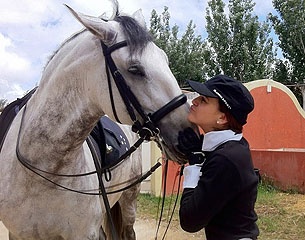
When the going gets tough, the tough get going, right? In dressage this is not the case, and going faster or more forward, or moving into a more active gait will not solve the problem. The underlying and very valuable truth is that whatever issues you have in the walk will certainly be present in the trot and canter, and whatever cannot be solved at the walk, certainly will not be solved by simply moving into trot.
There is one exception and that is if you are on a horse that is too fresh, young, or is in a strange environment and needs to be trotted a little before coming back to the walk. However, having trouble finding the contact, rhythm, balance, engagement, or any or all of the above will not be solved by simply switching to trot.
I say the walk is the most difficult pace to ride because it takes the most feeling, the most patience, the most attention to detail. If you come out on the arena and the horse is coming behind the contact, leaning on the bit, falling onto the shoulders, or walking like a drunk on his way home from a boozy Friday, then chances are launching into the trot will be the quickest and easiest option.
Once in the trot you can simply push the horse forward and fly off into a forward free for all and with a pull here and a push there to hide all the very obvious signs that the horse was not on your aids to begin with.
The minute you start the walk, you must learn to ride the walk, a thing that many of us simply forget. We think it is that thing you do on the way to the arena and on the way home, and forget that the walk is the single most important variable in any of the advanced movements of collection, and really the most important gait in dressage.
It is from collecting the walk that the horse learns piaffe, so if when you try to ride the walk, let it out a little or bring it back a little, your horse comes behind the bit, what hope do you have of keeping him in front of the vertical later on in piaffe?
When you do a canter pirouette does your horse's nose come behind the vertical? Chances are when you try to collect the walk, he does the same, because he has not learnt to collect the walk effectively and engage his hindquarters from behind. Instead he has learnt to collect himself from front to back and so the minute you ask him to sit, he simply sucks back, unable to understand your aid.
Walk, think about what you feel in the walk! Is the rhythm the same? Is my horse leaning on the bit, or coming off the contact? Is his mouth relaxed and he is able to gently mobilise his mouth and jaw, or is he fixed, or with his mouth open, or grinding as if he is sharpening tools for battle?
If you feel that the horse is not walking into an elastic contact, even on both reins, and is able to move on and come back without altering his balance, you must think on how you can improve his work and how you can improve your own effectiveness of riding him at the walk. Start to work the walk. Don’t just think "oh great this is his walk I’m stuck with it."
Just as you work the trot and canter, with transitions going on and coming back, you must also work the walk. You must employ bending, making sure you don’t lose the contact on the outside rein, and you keep the hind legs steeping up underneath him. Over time you will discover how to feel the walk, how to feel his back in the walk, and how to ride your horse from the back to the front.
If you can learn this art, the art of riding the walk, you will be in control of your horse and his body when you go to trot. You will be able to identify where his balance is and how to correct it and if you feel yourself losing it, and feel he is taking over, come back to walk!
There is a reason why the walk is difficult to ride: it is because you can feel everything more clearly. When you can learn to seek out and find solutions for the balance, contact, rhythm, straightness and engagement issues at the walk, you will find that the trot and canter work will be ready for you to master!
You must walk before you can run; true in life and in dressage!
by Sarah Warne